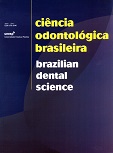Avaliação clínica da adaptação de apoios em cíngulo para prótese parcial removível
DOI:
https://doi.org/10.14295/bds.2005.v8i3.425Abstract
O objetivo deste trabalho in vivo foi avaliar a adaptação de apoios em cíngulo confeccionados sobre esmalte ou resina composta em Próteses Parciais Removíveis. Após a prova e ajuste da armação metálica e anteriormente ao registro da relação maxilo-mandibular foram selecionados caninos com apoios considerados adaptados clinicamente, totalizando uma amostra de 16 apoios em esmalte (Grupo A) e 16 apoios em resina composta (Grupo B). A adaptação foi verificada utilizando uma silicona por condensação leve (Heraeus Kulzer). O material foi manipulado e colocado na face interna do apoio, em seguida a armação metálica foi inserida na boca de acordo com a trajetória de inserção até a posição de assentamento final. Após a polimerização, o material adere a armação metálica que foi removida da boca. Outra silicona por condensação média (3M) foi colocada sobre o material anterior, formando o corpo-de-prova, que foi seccionado longitudinalmente na região mais profunda do preparo. Sua espessura mostrou o grau de adaptação entre a fundição e o dente suporte. As medidas foram feitas utilizando projetor de perfil (MP320- Carl Zeiss, JENA). Os resultados foram analisados através do Teste de Mann-Whitney (5%), onde foi observada uma diferença significante (p=0,017) entre os dois grupos(Grupo A= 0,584 ± 0,325mm e Grupo B= 0,311 ± 0,237mm). Os apoios confeccionados sobre resina composta apresentaram uma melhor adaptação ao preparo para apoio do que os realizados sobre esmalte.Downloads
Downloads
Published
How to Cite
Issue
Section
License
Brazilian Dental Science uses the Creative Commons (CC-BY 4.0) license, thus preserving the integrity of articles in an open access environment. The journal allows the author to retain publishing rights without restrictions.
=================




























